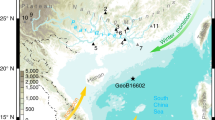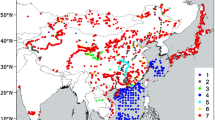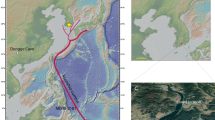Abstract
Fossil pollen records from 45 sites across China were evaluated and synthesized to document vegetation and climate change during Marine Isotope Stage 3 (MIS 3) at 60–27 ka and to understand the large-scale controls. During MIS3, vegetation type was dominantly forest in eastern China, forest steppe/meadow in the north and Tibetan Plateau, and steppe desert in northwestern arid China. We developed a semi-quantitative vegetation index to reflect change in plant abundance (by inferring the general climate conditions), with a vegetation score from 1 to 3 based on the different vegetation types inferred from pollen data at individual sites at intervals of 2,000 years. The reconstructed vegetation index shows higher values during MIS 3, especially during the period 53–40 ka, than at the Last Glacial Maximum. Our results also suggest that climate on the basis of vegetation change was cooler and drier during MIS 3 than during the Holocene optimum; however, MIS 3 vegetation was probably similar to modern vegetation. The close relationship between vegetation change, insolation and Asian summer monsoon strength suggests that climate variations, probably in both temperature and precipitation, are the primary drivers of regional vegetation change. Additional well-dated, high-resolution palaeoclimate records from many locations across China will be needed to understand the vegetation change and climate forcings on millennial and centennial scales within MIS 3.





Similar content being viewed by others
References
Allen JRM, Brandt U, Brauer A et al (1999) Rapid environmental changes in southern Europe during the last glacial period. Nature 400:740–743
Voelker AHL, Workshop Participants (2002) Global distribution of centennial-scale records for Marine Isotope Stage (MIS) 3: a database. Quat Sci Rev 21:1185–1212
Huntley B, Alfano MJ, Allen JRM et al (2003) European vegetation during Marine Oxygen Isotope Stage-3. Quat Res 59:195–212
van Meerbeeck CJ, Renssen H, Roche DM (2009) How did Marine Isotope Stage 3 and last glacial maximum climates differ? Perspectives from equilibrium simulations. Clim Past 5:33–51
Dansgaard W, Johnsen SJ, Claussen HB et al (1993) Evidence for general instability of past climate from a 250 year ice-core. Nature 364:218–220
North Greenland Ice Core Project Members (2004) High resolution record of Northern Hemisphere climate extending into the last interglacial period. Nature 431:147–151
Herzschuh U (2006) Palaeo-moisture evolution in monsoonal Central Asia during the last 50,000 years. Quat Sci Rev 25:163–178
Shi YF (2002) Characteristics of late Quaternary monsoonal glaciation on the Tibetan Plateau and in East Asia. Quat Int 97–98:79–91
Shi YF, Yu G (2003) Warm-humid climate and transgressions during 40–30 ka BP and their potential mechanisms. Quat Sci 23:1–11 (in Chinese)
Yang B, Shi YF, Braeuning A et al (2004) Evidence for a warm-humid climate in arid northwestern China during 40–30 ka BP. Quat Sci Rev 23:2537–2548
Yu G, Xue B, Wang SM (2002) Reconstruction of Asian palaeomonsoon patterns in China over the last 40 kyrs: a synthesis. Quat Res 41:23–33
Yu G, Gui F, Shi YF et al (2007) Late marine isotope stage 3 palaeoclimate for East Asia: a data-model comparison. Palaeogeogr Palaeoclimatol Palaeoecol 250:167–183
Reimer PJ, Baillie MGL, Bard E et al (2009) INTCAL 09 and MARINE09 aadiocarbon age calibration curves, 0–50,000 years Cal BP. Radiocarbon 51:1111–1150
Hou X (2001) Vegetation altas of China. Science Press, Beijing (in Chinese)
Zheng Z, Lei ZQ (1999) A 400,000 year record of vegetaitonal and climatic changes from a volcanic basin, Leizhou Peininsula, southern China. Palaeogeogr Palaeoclimatol Palaeoecol 145:339–362
Zhang YL, Yu SH (1999) Palynological assemblages of late Quaternary from the Shenzhen region and its palaeoenvironment evolution. Mar Geol Quat Geol 19:109–114 (in Chinese)
Zheng Z (1990) The Holocene spore-pollen and palaeoenvironment in Chao-Shan Plain. Trop Oceanol 9:31–38
Huang ZG, Zhang WQ, Jiang LM (2003) Climatic characteristics in tropic areas of China during MIS-3. Quat Sci 23:77–82
Huang ZG, Li PR, Zhang ZY (1982) The formation and development of the Pearl River Delta. Popular Science Press, Beijing, pp 118–131 (in Chinese)
Chen MH, Zhao HT, Wen XS et al (1994) Quaternary foraminiferal group and sporopollen zones in cores L2 and L16 in the Lingdingyang Estuary. Mar Geol Quat Geol 14:11–22 (in Chinese)
Yan S, Mu GJ, Xu YQ et al (1998) Quaternary environmental evolution of the Lop Nur region, China. Acta Geogr Sin 53:333–340 (in Chinese)
Sun XJ, Li X, Luo YL et al (2000) The vegetation and climate at the last glaciation on the emerged continental shelf of the South China Sea. Palaeogeogr Palaeoclimatol Palaeoecol 160:301–316
Zheng Z (1991) Distribution of Dacrydium in south China during the late Quaternary. Acta Bot Sin 33:130–139 (in Chinese)
Tang LY (1992) Vegetation and climate history at Menghai, Yunnan during the past 42,000 years. Acta Micropalaeontol Sin 9:433–455 (in Chinese)
Yang XD, Wang SM, Tong GB et al (1998) The late Pleistocene pollen record in the lake sediments from ancient Heqing Lake and its significance for palaeoclimate. Quat Sci 4:335–343 (in Chinese)
Qin Y, Fei AW, Jin KL et al (1992) Late Pleistocene sporopollen assemblages and evolution of palaeovegetation, palaeoclimate and palaeoenvironments in Tengchong Basin, western Yunnan. Mar Geol Quat Geol 12:109–118 (in Chinese)
Wu YS, Chen YS, Xiao JY (1991) A preliminary study on vegetation and climate changes in Dianchi Lake area in the last 40000 years. Acta Bot Sin 33:450–458 (in Chinese)
Kuang MS, Xie SY, Zeng Y et al (2002) Study on the palaeovegetation and palaeoclimate since late Pleistocene in the Dianchang Mountain Area in Dali of Yunnan Province. J Southwest China Normal Univ (Nat Sci) 27:759–765 (in Chinese)
Wu YH, Yang XD, Wang SM (1997) Environmental change in the Poyang Lake Area during late-Pleistocene. J Geomech 3:69–76 (in Chinese)
Zhou S, Zou SM, Liu ZP et al (2001) Quaternary pollen analysis and palaeo-environmental evolution in the northern part of Taihu Plain, Jiangsu. Acta Micopalaeontol Sin 18:70–75 (in Chinese)
Yang JM (1992) The phases of peat formation and their relationships to climatic and sea-level changes in coastal area of Fujian during late Quaternary. Trop Oceanol 11:45–51 (in Chinese)
Kong ZC, Du NQ (1980) Vegetational and climatic changes in the past 30,000–10,000 years in Beijing. Acta Bot Sin 22:330–338 (in Chinese)
Jie DM, Lu JF (1995) The time-space change of precipitation and aridity degree of Songnensandland since last glacial age. Sci Geogr Sin 15:337–343 (in Chinese)
Xu JS, Meng Y, Zhang XL et al (2006) Palaeogeographic environmental evolution in the Huanghe River Estuary since late Pleistocene. Quat Sci 26:327–333 (in Chinese)
Feng ZD, Tang LY, Ma YZ et al (2007) Vegetation variations and associated Environmental changes during marine isotope stage 3 in the western part of the Chinese Loess Plateau. Palaeogeogr Palaeoclimatol Palaeoecol 246:278–291
Jiang HC, Mao X, Xu HY et al (2011) Last glacial pollen record from Lanzhou (Northwestern China) and possible forcing mechanisms for the MIS 3 climate change in Middle to East Asia. Quat Sci Rev 30:769–781
Sun XJ, Song CQ, Wang FY et al (1997) Vegetation history of the Loess Plateau of China during the last 100,000 years based on pollen data. Quat Int 37:25–36
Li BC, Sun JZ (2004) Vegetation and climate environment during the late Pleistocene in Loess Plateau, China. Geogr Res 23:641–648
Ke MH, Sun JZ, Zhao JB (1993) Palaeoclimatological and palaeoenvironmental change in the Fu County since the last interglacial. J Xi’an Geol Coll 15:172–177 (in Chinese)
Zhao JB (1995) Holocene high resolution climate records from Qishan, Shanxi. J Geogr 50:45–50 (in Chinese)
Tang, LY, Kang JC, Feng ZD (1991) The climatic cycles recorded by Loess sections in Lanzhou region. Quaternary glacial and environment in Western China. Science Press, Beijing, pp 237–243 (in Chinese)
Li JJ, Feng ZD, Tang LY (1988) Late Quaternary monsoon patterns on the Loess Plateau of China. Earth Surf Proc Land 13:125–135
Ma YZ, Cao JX, Li JJ (1995). Vegetation development and climate change inferred from pollen records of Yuanbao loess section at Linxia, Gansu. In: Expert Committee of Qingzang Project (ed) The formation and evolution, environmental change and ecosystem study on the Tibetan Plateau. Science Press, Beijing, pp 103–133
Tang LY, Shen CM, Kong ZC et al (1998) Pollen evidence of climate during the last glacial maximum in Eastern Tibetan Plateau. J Glaciol Geocryol 20:133–140 (in Chinese)
Ma YZ, Zhang HC, Li JJ (1998) On the evolution of the palynoflora and climatic environment during late Pleistocene in Tengger Desert, China. Acta Bot Sin 40:871–879 (in Chinese)
Zhang HC, Wuennemann B, Ma YZ et al (2002) Lake level and climate changes between 42,000 and 18,000 14C a BP. in the Tengger Desert, Northwestern China. Quat Res 58:62–72
Rhodes TE, Gasse F, Lin RF et al (1996) A late Pleistocene-Holocene lacustrine record from Manas, Zunggar (northern Xinjiang, western China). Palaeogeogr Palaeoclimatol Palaeoecol 120:105–121
Shi YF, Qu YG (1989) Water resources and environment in Chaiwobu–Dabancheng Region. Science Press, Beijing, pp 1–10 (in Chinese)
Wen XH, Li BS, Zheng YM et al (2009) Climate variability in the Salawusu River valley of the Ordos Plateau (Inner Mongolia, China) during Marine Isotope Stage 3. J Quat Sci 24:61–74
Shen CM, Tang LY, Wang SM et al (2005) Pollen record and chronology from the Core RM in the Zoige Basin. Chin Sci Bull 50:246–254
Shan FS, Du NQ, Kong ZC (1993) Vegetation and environmental change in the Qinghai Lake basin over the last 350,000 years. J Lake Sci 5:9–17 (in Chinese)
Tang LY, Wang SL (1988) Vegetation of Gonghe Group in the Gonghe Basin, Qinghai. Acta Palaeontol Sin 27:583–606
Huang CX, Wang A, Liang YL (1983) Holocene Environmental change inferred from pollen records in the central and southern Tibet. Quaternary geology in Tibet. Science Press, Beijing, pp 179–192
Xiao JY, Wu YS, Zheng MP (1996) A preliminary study on lake Quaternary flora in Chabyer Caka Salt Lake, Xizang (Tibet). Acta Micropalaeontol Sin 13:395–399 (in Chinese)
Huang CX, Zhang QS (1989) A preliminary study of palaeovegetation and palaeoclimate in the later period of late Pleistocene in the Bangongcuo Lake region of Xizang. J Nat Res 4:247–253 (in Chinese)
Du NQ, Kong ZC (1983) Palynoflora of the Qarhan saline lake and its significance in geography and botany-thesporo-pollen assemblages from CK2022 drilling core at theBieletan. Acta Bot Sin 25:275–282 (in Chinese)
Zhu DG, Meng XG, Zhao XT (2004) Evolution and climate change of Nam Co of Tibet and an ancient large lake in the northern Tibetan Plateau since the late Pleistocene. Geol Chin 31:269–277 (in Chinese)
Wang YJ, Cheng H, Edwards RL et al (2001) A high-resolution absolute-dated late Pleistocene monsoon record from Hulu Cave, China. Science 294:2345–2348
Thompson LG, Yao T, Davis ME et al (1997) Tropical climate instability: the last glacial cycle from a Qinghai–Tibetan ice core. Science 276:1821–1825
Berger A, Loutre MF (1991) Insolation values for the climate of the last 10 million years. Quat Sci Rev 10:297–317
Bard E (2002) Abrupt climate changes over millennial time scales: climate shock. Phys Today 55:32–38
Lisieki LE, Raymo ME (2005) A Pliocene–Pleistocene stack of 57 globally distributed benthic δ 18O records. Palaeoceanography 20:PA1003
Monnin E, Steig EJ, Siegenthaler U et al (2004) Evidence for substantial accumulation rate variability in 32 Antarctica during the Holocene, through synchronization of CO2 in the Taylor Dome, 33 Dome C and DML ice cores. Earth Planet Sci Lett 224:45–54
Watts WA, Hanssen BCS, Grimm EC (1992) Camel Lake: a 40,000-yr record of vegetational and forest history from northwest Florida. Ecology 73:1056–1066
Anderson RS, Betancourt JL, Mead JI et al (2000) Middle- and late-Wisconsin palaeobotanic and palaeoclimatic records from the southern Colorada Plateau, USA. Palaeogeogr Palaeoclimatol Palaeoecol 155:31–57
Anderson PM (1988) Late Quaternary pollen records from the Kobuk and Noatak River drainages, northwestern Alaska. Quat Res 29:263–276
Anderson PM, Bartlein PJ, Brubaker LB (1994) Late Quaternary history of tundra vegetation in northwestern Alaska. Quat Res 41:306–315
Whitlock C, Bartlein PJ (1997) Vegetation and climate change in the northwest America during the last 125 ka. Nature 388:57–61
Grigg LD, Whitlock C (2001) Evidence for millennial-scale climate change during marine isotope stages 2 and 3 at Little Lake, Western Oregon, USA. Quat Res 56:10–22
Bonnefille R, Chalie F (2000) Pollen-inferred precipitation time-series from equatorial mountains, Africa, the last 40 ka BP. Glob Planet Change 26:25–50
Nakagawa T, Tarasov PE, Nishida K et al (2002) Quantitative pollen-based climate reconstruction in central Japan: application to surface and Late Quaternary spectra. Quat Sci Rev 21:2099–2113
Johnson BJ, Miller GH, Fogel ML et al (1999) 65,000 years of vegetation change in central Australia and the Australian summer monsoon. Science 284:1150–1152
Cheng H, Zhang PZ, Spötl C et al (2012) The climatic cyclicity in semiarid-arid central Asia over the past 500,000 years. Geophys Res Lett 39:L01705
Zhao Y, Yu ZC, Yu T et al (2014) Peatland initiation and carbon accumulation in China over the last 50,000 years. Earth Sci Rev 128:139–146
Wu HB, Guiot J, Brewer S et al (2007) Dominant factors controlling glacial and interglacial variations in the tree line elevation in tropical Africa. Proc Natl Acad Sci USA 104:9720–9724
Herzschuh U, Ni J, Birks HJB et al (2011) Driving forces of mid-Holocene vegetation shifts on the upper Tibetan Plateau, with emphasis on changes in atmospheric CO2 concentrations. Quat Sci Rev 30:1907–1917
Acknowledgments
We thank Wenwei Zhao for digitizing pollen data and plotting some figures. This work was supported by the Hundred Talents Programme of the Chinese Academy of Sciences, the National Natural Science Foundation of China (41125006, 41330105), and Humboldt Research Fellowship for Experienced Researchers.
Conflict of interest
The authors declare that they have no conflict of interest.
Author information
Authors and Affiliations
Corresponding author
Electronic supplementary material
Below is the link to the electronic supplementary material.
About this article
Cite this article
Zhao, Y., Yu, Z., Herzschuh, U. et al. Vegetation and climate change during Marine Isotope Stage 3 in China. Chin. Sci. Bull. 59, 4444–4455 (2014). https://doi.org/10.1007/s11434-014-0611-0
Received:
Accepted:
Published:
Issue Date:
DOI: https://doi.org/10.1007/s11434-014-0611-0




